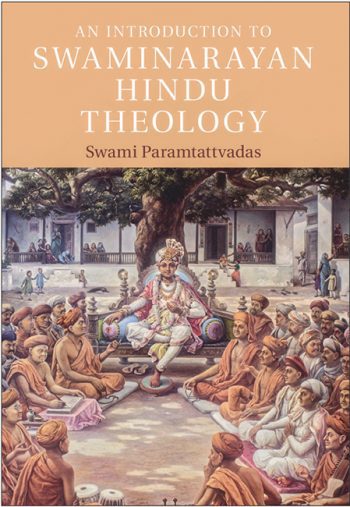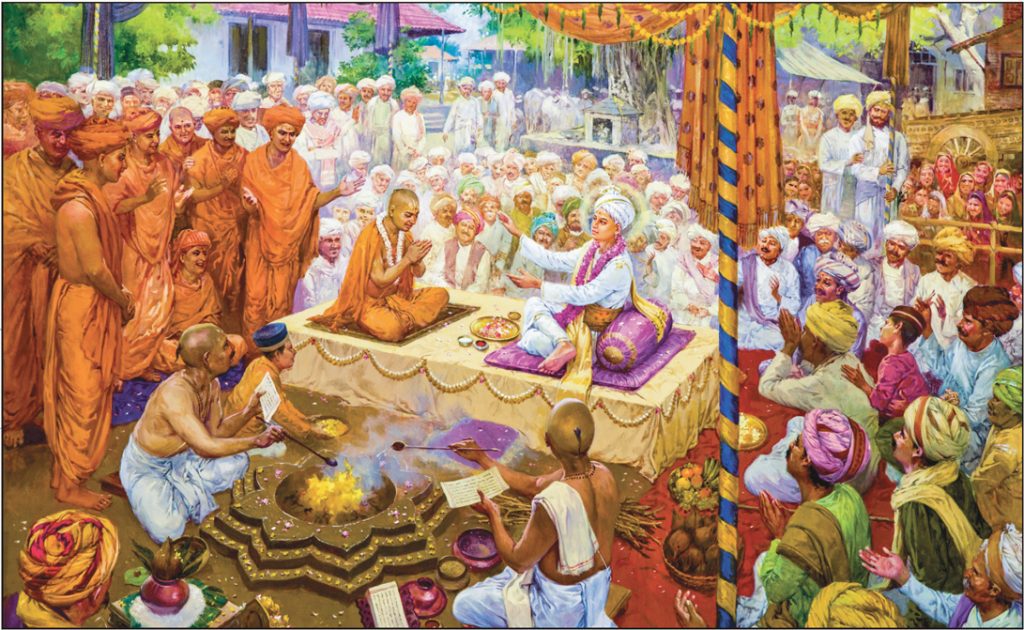Swami Paramtattvadas offers a technical, yet approachable, analysis
BY SHANNA N. PATEL
Swaminarayan Hinduism maintains a significant presence both in India and the Hindu diaspora. Founded at the beginning of the 19th century by Sahajanand Swami—referred to by followers as Bhagwan Swaminarayan—the tradition now has millions of followers. The lineage has become well-known for its ornate temples around the world, of which there are over a thousand. Despite its being a highly recognizable face of Hinduism, relatively little academic work has been done in English on the Swaminarayan sampradaya’s core beliefs. An Introduction to Swaminarayan Hindu Theology sets out to systematize and document the doctrines that undergird its expressions of devotion and faith.
With a unique personal and educational background, the author is well-placed to examine the Swaminarayan belief system and present it in an engaging manner to varied readerships. Swami Paramtattvadas was born and brought up in the United Kingdom and subsequently renounced his lifestyle in 1992 to be ordained as a swami of the Bochasanwasi Shri Akshar Purushottam Swaminarayan Sanstha (BAPS), one of the largest denominations of the Swaminarayan sampradaya. He subsequently completed 14 years of studies in India, both in a traditional ashram and in a modern university setting. Equipped with a strong background in Sanskrit and Vedanta, he then entered the Western academic world to study theology and religious studies at the University of Oxford, completing his doctoral thesis under the supervision of Gavin Flood, Professor of Hinduism at Oxford. Swami’s book is a developed form of that thesis. As Professor Francis X. Clooney, a comparative theologian of Harvard Divinity School, rightly points out, the author’s deep immersion within the tradition and his unique perspective allow him to bring together his Western and Indian disciplines to treat the subject systematically yet accessibly.
Echoing the views of eminent scholars of Hinduism such as Clooney and Julius Lipner, Paramtattvadas first establishes the pressing need for scholarly exploration in English of core Hindu beliefs by practitioners—that is to say, Hindu theology by Hindus. Such an exercise, expressed in accessible academic English, not only “take[s] Hindu theology beyond its usual national and linguistic borders” but also, crucially, “affirms the viability, validity and value of Hindu theology more generally.” His methodology is described as “systematic theology,” which draws on the basic framework of classical theological analysis. Recognizing that the task involves the translation of deep ideas and concepts, which is much more difficult than simple linguistic translation, the author does well in finding a happy middle between the use of native expressions and common English theological terms.
Paramtattvadas employs a two-part structure in his book. First, he presents the tools and sources of theology that prepare the reader to engage with the principles of Swaminarayan Hinduism in a meaningful way. With this background, he proceeds in the second part to dive deep into the defining aspects of the tradition’s theological system. He explains that this structure “allows the book to cover the three key topics associated with classical Vedantic inquiry: pramana-mimamsa (epistemology), tattva-mimamsa(metaphysics) and mukti-mimamsa (soteriology).”
In the afterword, the author discusses various avenues for scholarly enquiry for those with an interest in Swaminarayan Hinduism, Hindu doctrine more generally, and (inter-religious) comparative theology. The book’s well-organized structure is complemented by Paramtattvadas’s lucid writing style; the book will thoroughly engage scholars of theology and those with familiarity in Vedanta while providing a challenging, yet rewarding, read to the layperson.

Theology as an academic discipline is, in simple terms, the attempt to understand the Divine. Paramtattvadas points out that before we can begin such an endeavor, we must ask, “Can God be known at all?” He goes on to juxtapose statements of shastra that, on the one hand convey the imperceptibility and ineffability of God, and on the other emphasize the imperative of knowing or realizing God. Here, he introduces the key tool of (Swaminarayan Hindu) theology: revelation. The author explains that God can only be properly known when He reveals Himself. In addition to the scriptural sources of revelation (i.e., the sermons of Bhagwan Swaminarayan and his subsequent lineage of gurus) where God “tell[s] us what He is like,” Paramtattvadas posits that revelation also includes the instances where God “show[s] us who He is.” For the latter, therefore, the author includes the “self-manifestation of Parabrahman in the person of Swaminarayan” and the continued presence of God in the guru. While establishing revelation as the highest pramana, Paramtattvadas coherently explains the vital roles of reason, praxis and tradition as tools in theological exploration.
Central to any Hindu school of the thought is its understanding of metaphysical entities. Monism defines Sankara’s thought, just as Ramanuja makes a case for his “jiva-jagat-jagdish” trio. Swami Paramtattvadas explicates Bhagwan Swaminarayan’s philosophy of five distinct and eternal metaphysical entities: Parabrahman, Aksharbrahman, maya, ishvara and jiva. In addition to being endowed with the commonly attributed characteristics of being omnipotent, omniscient, omnipresent, omnibenevolent, etc., Parabrahman in Swaminarayan theology is above all recognized as being pragata(manifest before one’s eyes), sakara (eternally possessing a form), sarvopari (supreme to all), and karta (cause and support of all). Knowing God is the foremost principle of Swaminarayan Hindu theology; Paramtattvadas contends that all religious endeavors must be grounded in, revolve around, and have as their aim the complete knowledge of God.
The author elaborates in detail on each of the five entities. Perhaps one of the most noteworthy aspects of the Swaminarayan tradition is its distinction between two types of Brahman: Parabrahman and Aksharabrahman. Paramtattvadas clarifies this unique Swaminarayan understanding, offering scriptural support from Swaminarayana-Bhashya,the tradition’s Vedanta commentaries, and notes that both entities manifest in human form. Most interestingly, he discusses the notion that Parabrahman maintains a substantive presence on Earth through Aksharbrahman in the form of the Brahmasvarupa Guru. Indeed, we discover that the guru is wholly central to the Swaminarayan theological system in his chapter on mukti. Paramtattvadas explains that the means to liberation is to realize oneself as “brahmarupa” by spiritually associating with the Aksharabrahman guru in order to offer perfect devotion to Swaminarayan as Parabrahman.

This book is a comprehensive introduction to Swaminarayan Hindu theology that will be an enlightening resource for many a reader. It is worth noting that the publication has received significant acclaim from esteemed members of the academia. At a book launch for the event in America, Professor Raymond Williams, who himself has worked on the Swaminarayan tradition for almost 40 years, praised the book, saying it is “written in beautiful English, and it is accessible and compatible with the best of Western scholarship.” Indeed, the book was recently subject of a specially commissioned review essay in the esteemed Harvard Theological Review in which respected professor of comparative theology at Boston College, Catherine Cornille, correctly summarizes that the book is “a very important contribution to Hindu thought” in general and “an invaluable resource for those belonging to the tradition.” Both scholars speak to the accessible tone employed by Swami Paramtattvadas as well as the rigorous and systematic way in which he approaches the subject. Professor Cornille goes on to write, “The vitality of a tradition may be seen to lie in the willingness and ability of its own intellectuals to reflect creatively on the meaning of the tradition in light of both past and present theological ideas and thus to move the tradition forward.” Swami Paramtattvadas has not only enriched our understanding of Swaminarayan Hinduism but has invigorated a desperately-needed discourse on Hindu theology in the scholarly world, a discourse in which a Hindu voice is a welcome addition.
